Accelerator Mass Spectrometry
Calibration Curve from AD 1250 to AD 1650 by Measurements of Tree-Rings Grown on the Korean Peninsula
Wan Hong, J. H. Park, W. K. Park, K. S. Sung, K. H. Lee, G. Park, Y. E. Kim, J. K. Kim, H. W. Choi, G. D. Kim, H. J. Woo, T. G. Nam, Nucl. Instrum. Methods B 294 (2013) 435-439
A 1MV AMS machine installed at Korea Institute of Geoscience and Mineral Resources (KIGAM) in 2007 has been dedicated to study on paleoclimate change and the environmental study. Because possibility of regional age offset has been suggested by several previous studies, the consistency of the data set of IntCal04, which is used to calibrate radiocarbon ages in our laboratory, with data obtained from 14C in tree rings grown in the Korean peninsula has been examined in this study. Tree-ring samples were collected from the building materials of Korean historical wooden buildings. Remaining historical records regarding the construction times of the buildings were consulted. The ages of the tree-ring samples ranged from AD 1250 to AD 1650 and were measured by dendrochronological method. After the samples were cut into single-year rings, alpha cellulose was extracted from each ring. Then, their annual 14C concentrations were measured by AMS. Accurate radiocarbon ages during the 400 year period were evaluated from the concentrations. The ages of the tree rings were compared with the IntCal04 calibration curve. The average deviation of 14C concentration was calculated to be -2.14‰. By the Fourier transform of the single-year variation of the concentration, six major periodic compositions could be found. One of the compositions has a period of 10.9 years and it is thought to be related to a sunspot variation known as the Schwabe variation, which covers a period of 11 years.
-
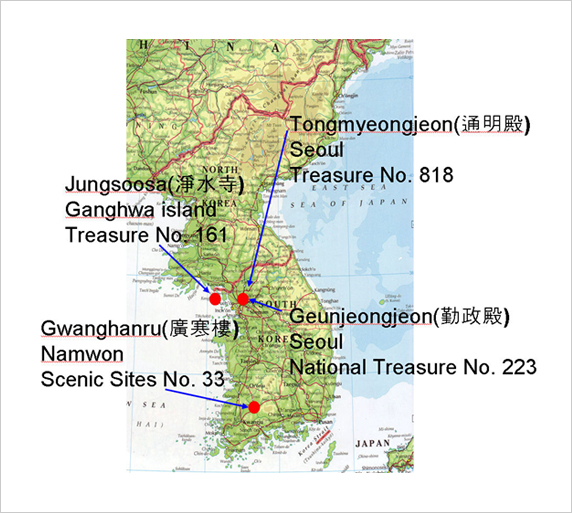
The sampling sites. Seven samples collected from building materials of four historical buildings were used in this work.
-
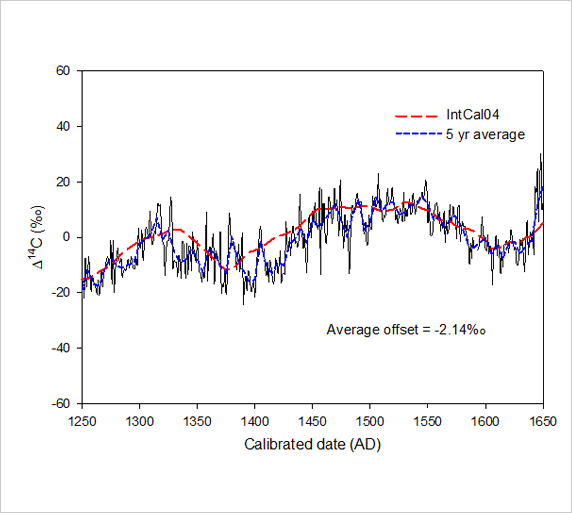
A variation curve (solid line) of radiocarbon concentration in the Korean atmosphere from AD 1250 to AD 1650. Dashed line represents IntCal04 data and dotted line is smoothed by averaging over every 5 years. The average offset is -2.14‰.
-

Periodic compositions of 14C variation in the atmosphere obtained by Fourier transform. Peaks with short periods (3years and 5.5 years) are estimated as noise factors. The peaks at 10.9 years and 23.9 years represent sunspot cycle and Hale Cycle, respectively. Other three peaks are currently unknown. Small figure shows fitting results of the peak at 10.9 years.
-
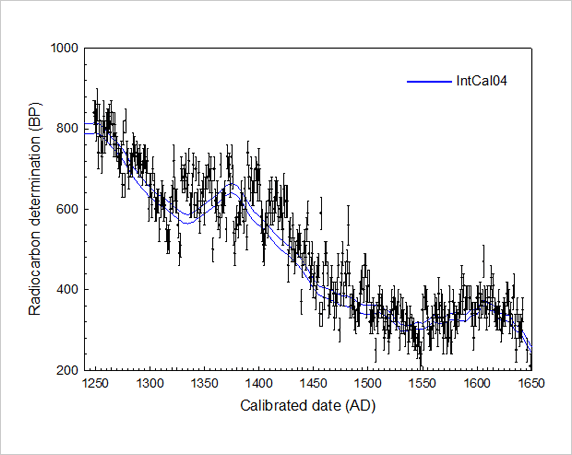
Comparison of 14C ages of Korean tree rings and their dendrochronological ages with the calibration curve of IntCal04 (solid line). Apparent deviation is recognised near the wiggle at AD 1370.
Regional offset of radiocarbon concentration and its variation in the Korean atmosphere from AD 1650 – AD 1850
Wan Hong, Jung Hun Park, Gyujun Park, Ki Suk Sung, Radiocarbon 55(2) (2013) 753-762
- A series of annual tree-ring measurements has been performed for the reconstruction of the radiocarbon concentration variation in the Korean atmosphere from AD 1650 to AD 1850. The absolute ages of the samples were determined by a dendrochronological method. An alpha cellulose extraction method was applied to the preparation of the tree-ring samples for precise radiocarbon measurements. The radiocarbon concentrations of the tree rings were plotted along with the dendrochronological ages.
During the period from AD 1650 to AD 1850, the discrepancy in the radiocarbon concentration in the Korean atmosphere from IntCal data is small enough to use IntCal data without any further correction. This is nearly one third of the average offset of the 400 years from AD 1250 to AD 1650. One of the reasons for the regional offset around Korea is thought to be the contribution of 14C-depleted CO2 released from the northern Pacific Ocean, where old deep water is upwelling to the surface. It is thought that the release rate of 14C-depleted CO2 decreased due to the temperature change during the Little Ice Age. -
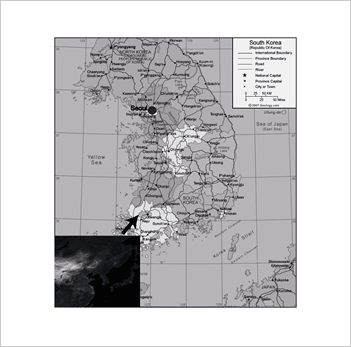
The location of the sampling site
-

The variation curve (solid line) of the radiocarbon concentration in the Korean atmosphere from AD 1650 to 1850. The dashed line represents the IntCal04 data and the dotted line is the Korean measurements smoothed by averaging every 10 years. The average offset is -0.79 ‰.
-
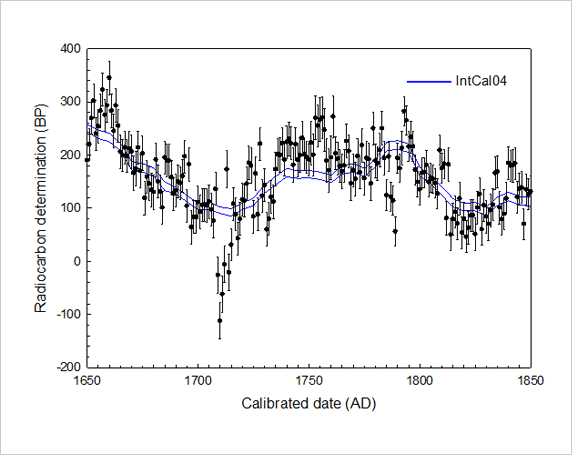
Comparison of 14C ages of Korean tree rings grown from AD 1650 to AD 1850 and their dendrochronological ages with the calibration curve of IntCal04 (solid line).
Study ofΔ14C peak(M12) in AD 775yr with AMS
Nature 486: 240-2, Radiocarbon 59:1147-1156
AMS(Accelerating Mass Spectrometer) technique has been developed at the Geo-Analysis Center, KIGAM, which widely is adopted for researches on global environmental changes. Study of Δ14C peak(M12) of AD 775yr using AMS helps for determining the precise eruption age of Mt. Baekdoo, delta 14C age.The precise eruption-age determination of Mt. Baekdoo is expected to give precious information on predicting the volcanism in the Korean peninsula.
-
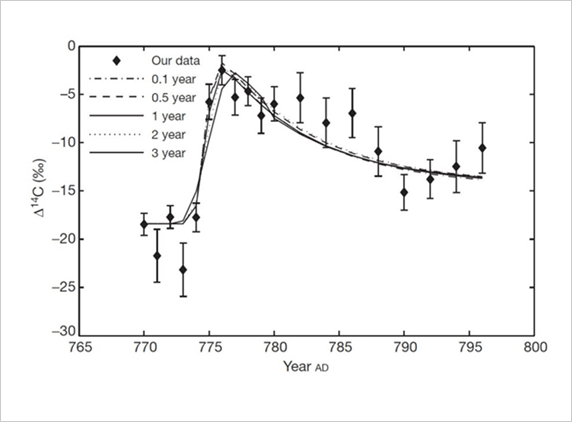
The result of Δ14C peak(M12) in AD 775yr by Miyake (Nature 486: 240-2)
-
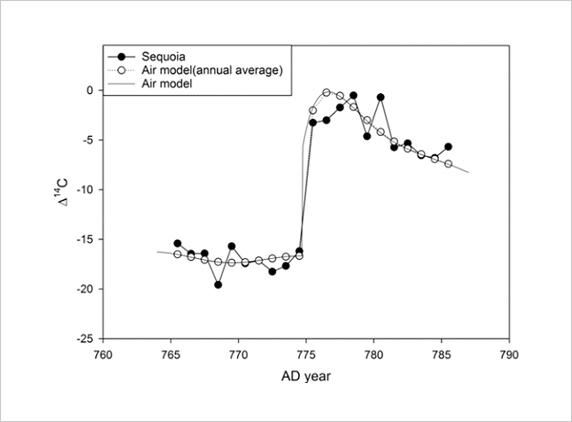
Re-verification of M12 peak by California Sequoia, concordant with the result from the AMS laboratory, Geo-Analysis center (Radiocarbon 59:1147-1156).
